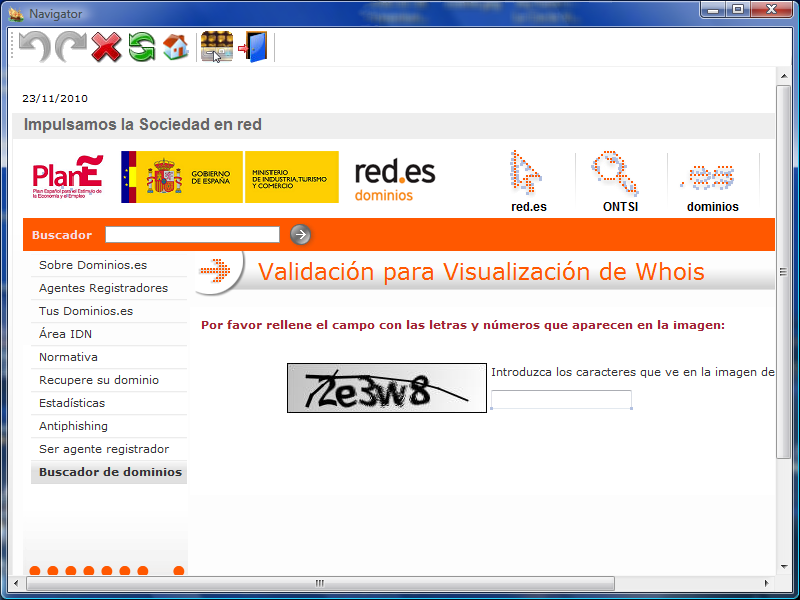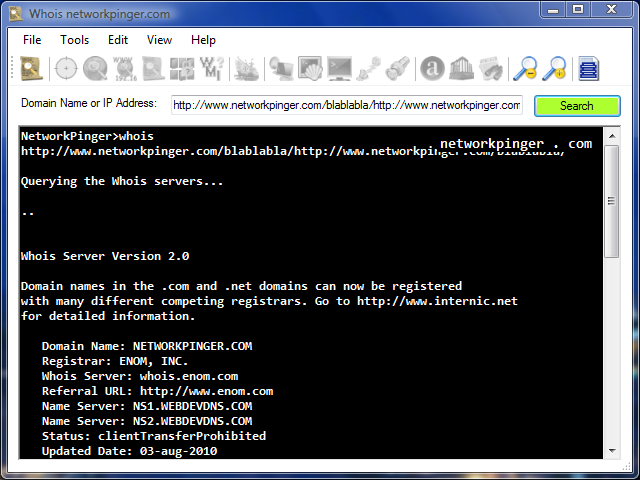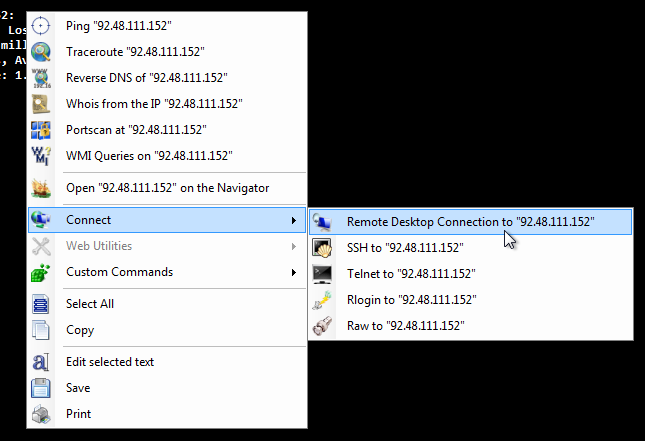Starting the Whois Tool
This Whois tool allows us to make an "Whois" to a domain name or IP address, which is nothing more than a simple request to the Whois servers to get the data about the register of a domain name and information about it, as well as data about an IP address, and to which ISP company it belongs, its country, etc. The Network Pinger software will do all the work of finding out if the inserted host is a valid IP address or domain name, and searching on the corresponding servers automatically to get all the information that is needed.
If the host is represented by an IP address, the server will search on the Whois servers that give information about IP addresses on the entire world according with their network, country or continent, servers like RIPE, ARIN, among others, until it gets the data we want. Unfortunately the software is ready to read the data and analyze them to decide if it has found the correct server or not, and there can be some changes on those servers or IP ranges in the future, and sometimes the software may not read well the information given by the server as it has to understand human language written in text, so some errors can happen with time as some IP addresses can be read by the wrong servers, but it is thought that those cases should usually be rare. The analysis made by the software is usually quick but sometimes it could take some time if it needs to investigate that IP address in many servers when it doesn't find the answer to where the IP address belongs to in the world. If the IP address has a response with some data from the correct entity, the information could be shown to the user in less than one second, and if it doesn't receive a response, a message saying that it didn't receive an answer would be shown to the user also.
About the domain names, each domain name shall have its related register, and the software only has a certain number of TLDs inserted on its database together with the register of each one of them, and although there are hundreds of TLDs inserted on its database, it can happen that after a new TLD appears, or if an old one is not inserted yet, that it can't get the information of certain domain names, but on those cases, the users feedback is very important and with it the software should add those new or missing TLD servers on its next versions. It is this way essential for the software to be updated from time to time to have all the TLDs inserted in its database. If the domain name exists, the information can be presented to the user in less than one second, and if it doesn't exist, an information saying that will be also presented on screen.
When talking about Internet domain names, there is an interesting functionality, which is that in case there is no Whois server for a certain TLD, making the user to be forced to check the domain name information in a specific website, the software could open that website automatically in a quick and easy way for the user to make the Whois query. On the example of the website below we have an Whois query about the Internet domain name "red.es", being that the .es domain names can only have their Whois information shown in a specific website from the Spanish "red.es", and the software in this case would open automatically this website:

On the example above, the user has made an Whois query to a Spanish TLD website, a .es, and Network Pinger has forwarded the user directly to the website "red.es", which is the one that gives us Whois information on Spanish domain names. Other domain names could be configured to be checked the same way if necessary. At the moment the data is saved on the Network Pinger software itself, so only with some user feedback could its database be updated to add other TLD cases in which it is necessary to check their data on a website instead of being checked through an Whois server. These .es TLDs will already have this functionality because it is configured this way on this software already since its initial versions.
This window will automatically do the Whois by default to the IP address or domain name given by the user when opened, and the user could do other ones later on the same window, just by changing the data in the text box mentioned below.
Lets now study this tool's several functionalities.
Command Panel

In this panel near the top of the window we just have two controls, a text input box and a button, which are here described:
- Domain Name or IP Address - It's on this box that we can write the domain name or IP address from which we want to see their Whois information. During the time when we're writing something on the text field, the software will be always trying to obtain the correct address which we're writing, even if it might contain errors, and filter any IP address or domain name from it in real time. If we paste there an IP address, or even two of them in the same line by mistake, as for example "http://www.networkpinger.com/blablabla/", we would have "http://www.networkpinger.com/blablabla/http://www.networkpinger.com/blablabla/" in the text field, and the software would automatically extract from it the correct address as we can see below:

 As we can see on the image above, the software was trying to find something valid through all those characters contained on the two addresses together, and to get the correct domain from them, in this case the networkpinger.com. Of course that, if two different domain names exist, the software will have to choose one which could be other than the one the user wanted, and it could even be unable to detect the correct address, but this functionality is very useful for those who may wish to simply copy an entire address from a website and put it on the software and let the software filter the domain or IP address inside of it. By filtering the IP address or domain name, the filtered address or domain would be written on the right top corner of the text box below the input field, and this way the user would always know what has been filtered by the software from the user inserted text, and in the case that nothing appears there on the corner, it would mean that no domain name or IP address was detected from what the user has inserted on the input field, and the Resolve button would become unavailable, and if something valid is detected, that button would be available to be clicked upon.
As we can see on the image above, the software was trying to find something valid through all those characters contained on the two addresses together, and to get the correct domain from them, in this case the networkpinger.com. Of course that, if two different domain names exist, the software will have to choose one which could be other than the one the user wanted, and it could even be unable to detect the correct address, but this functionality is very useful for those who may wish to simply copy an entire address from a website and put it on the software and let the software filter the domain or IP address inside of it. By filtering the IP address or domain name, the filtered address or domain would be written on the right top corner of the text box below the input field, and this way the user would always know what has been filtered by the software from the user inserted text, and in the case that nothing appears there on the corner, it would mean that no domain name or IP address was detected from what the user has inserted on the input field, and the Resolve button would become unavailable, and if something valid is detected, that button would be available to be clicked upon.
- Search -
 This is the button that executes the Whois command over what has been written on the input box whether it is a domain name or an IP address. After filtering, as it was described above, if the software is able to detect some domain name or IP address inside the text that the user has inserted, then as it was written above this button would become available to be clicked upon, and if not, it would become unavailable. The same way, the user could click on the Enter key when inside the "Domain Name or IP Address" box also, but anyway it would only return valid results if it had a valid domain name or IP address detected by the software. This button will be unavailable also when the software is executing an Whois request, to avoid that the user clicks on it before the former name resolution has ended.
This is the button that executes the Whois command over what has been written on the input box whether it is a domain name or an IP address. After filtering, as it was described above, if the software is able to detect some domain name or IP address inside the text that the user has inserted, then as it was written above this button would become available to be clicked upon, and if not, it would become unavailable. The same way, the user could click on the Enter key when inside the "Domain Name or IP Address" box also, but anyway it would only return valid results if it had a valid domain name or IP address detected by the software. This button will be unavailable also when the software is executing an Whois request, to avoid that the user clicks on it before the former name resolution has ended.
The Use of Mouse Buttons on the Text Box
When the Network Pinger software was being developed, it was intended to maintain a close relationship with the former command line tools and for that reason it was decided to maintain a text console on all the windows possible, only for the user to be more familiar with the tools and to be easier to read the results as well as to introduce new users to the world of the command line shells and their text mode commands. At the same time, they are used also to show what would be seen when an user decides to save a report of that command's results on a file or when a user decides to print a report.
This text box is used not only to give us an easy visualization of results, as well as to make a certain interaction between the user and this tool's results possible, and that is made through the toolbars, the menus, as well as the use of the mouse as we'll see below.
 It's important to know that in this text box we can do lots of things with just a simple left click of our mouse over any word. If we click on any word with our mouse's left button, the software will select that entire word automatically, and then if we click with the right button over that selection, we we'll get a menu with several options on tools that we can apply to the host that we've just selected, or our own customizable commands that we could apply to any word that we select on certain conditions. If we select a group of words, and then click on that selection with the right mouse button, the software will automatically search for the first host inside that selected text, or the first word in it, and it will be that the one to be used on the menu commands and options when we click with our mouse's right button on the selection. For more information it will be best to check the help page on Software Buttons and Menus.
It's important to know that in this text box we can do lots of things with just a simple left click of our mouse over any word. If we click on any word with our mouse's left button, the software will select that entire word automatically, and then if we click with the right button over that selection, we we'll get a menu with several options on tools that we can apply to the host that we've just selected, or our own customizable commands that we could apply to any word that we select on certain conditions. If we select a group of words, and then click on that selection with the right mouse button, the software will automatically search for the first host inside that selected text, or the first word in it, and it will be that the one to be used on the menu commands and options when we click with our mouse's right button on the selection. For more information it will be best to check the help page on Software Buttons and Menus.